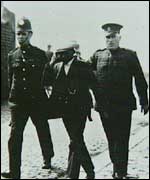|
The Yemeni race riots were remarkable events in the history of South Shields. The fuse which finally triggered both riots was a dispute over work and working conditions.
The story of the Yemeni riots begins at the end of the 19th century when seamen from Yemen settled in the town in the 1890s.
The Yemeni had left their own country to seek work on British
ships that passed through the colony of Aden.
For many, their journey eventually led them to North
East England.
Early Settlers
Once ashore in South Shields, the Yemeni often had trouble finding accommodation due to racial discrimination.
 |
|
Local Yemeni residents were proud of their traditions |
As a result, Ali Said opened the first Arab Seaman's Boarding House in August 1909 in the Holborn riverside district of South Shields.
The Yemeni community generally kept to themselves but the First World War was to change all that.
Manpower shortages in the navy led the government to encourage Yemeni men into the country. By the end of the war the Yemeni community in South Shields numbered 3,000.
The end of war saw the start of a campaign of racial violence and discrimination designed to drive Arabs out of the town.
It culminated in a dispute over jobs which sparked the first Yemeni riot in February 1919 when hundreds of white seamen clashed with Arabs at Mill Dam. Eight Arabs were sent to prison for their part in the riot.
Unprovoked attacks on Yemenis continued into the 1920s and
many lived in fear of their lives.
In one vicious attack, an Arab boarding house was attacked
and looted by a mob of white residents.
The 1930 Yemeni Riot
In 1930 a dispute broke out over working practices which the Yemeni seamen felt to be discriminatory.
 |
|
Police lead away one of the Yemeni protestors |
Fuelled by racial insults from a white worker called Hamilton, the dispute provoked another violent riot at Mill Dam in South Shields.
This time the police dealt harshly with the Arabs, using their batons on them, and attacking the men with force.
Fifteen Arabs were jailed and deported for their part in the riot including Ali Said who had spoken out about injustices but hadn't actually taken part in the riot itself.
The riot left a deep and lasting impression on the Arab community, and many were left shattered and impoverished.
"Since it is seems impossible to send these people home, the next best thing is to segregate them," said the Editor of the Shieldsman.
In response to criticism, an Arab, Hassan Mohamed, wrote
the following letter to the Evening Chronicle on Christmas Eve in 1931.
"I do not think the public know the extent to which
the Arabs are suffering. Many have to pawn clothing and other personal
belongings to buy food."
"There are scores of Arabs in Holborn who are living
on one meal a day... they only want a chance to earn a living and believe
that they only have the British flag behind them."
After the Riots
 |
|
The local paper reported 'a seething mass of fighting Arabs and police' |
The Yemeni community continued to experience prejudice and discrimination well into the 1930s.
Many had married local women, and this also outraged some white residents.
Eventually segregation plans were put into action by the council.
A small council estate was built in Holborn, and the
houses were rented out exclusively to the Arab community.
By the Second World War and the 1940s, attitudes became more relaxed towards the Yemeni.
The Arabs started to generate some support amongst the white community, and the papers began to print more sympathetic articles.
Even today, there remains a small Arab population in South Shields.
Many families still have the memories of their forefathers and can recall this hidden moment in Tyneside history.
|

